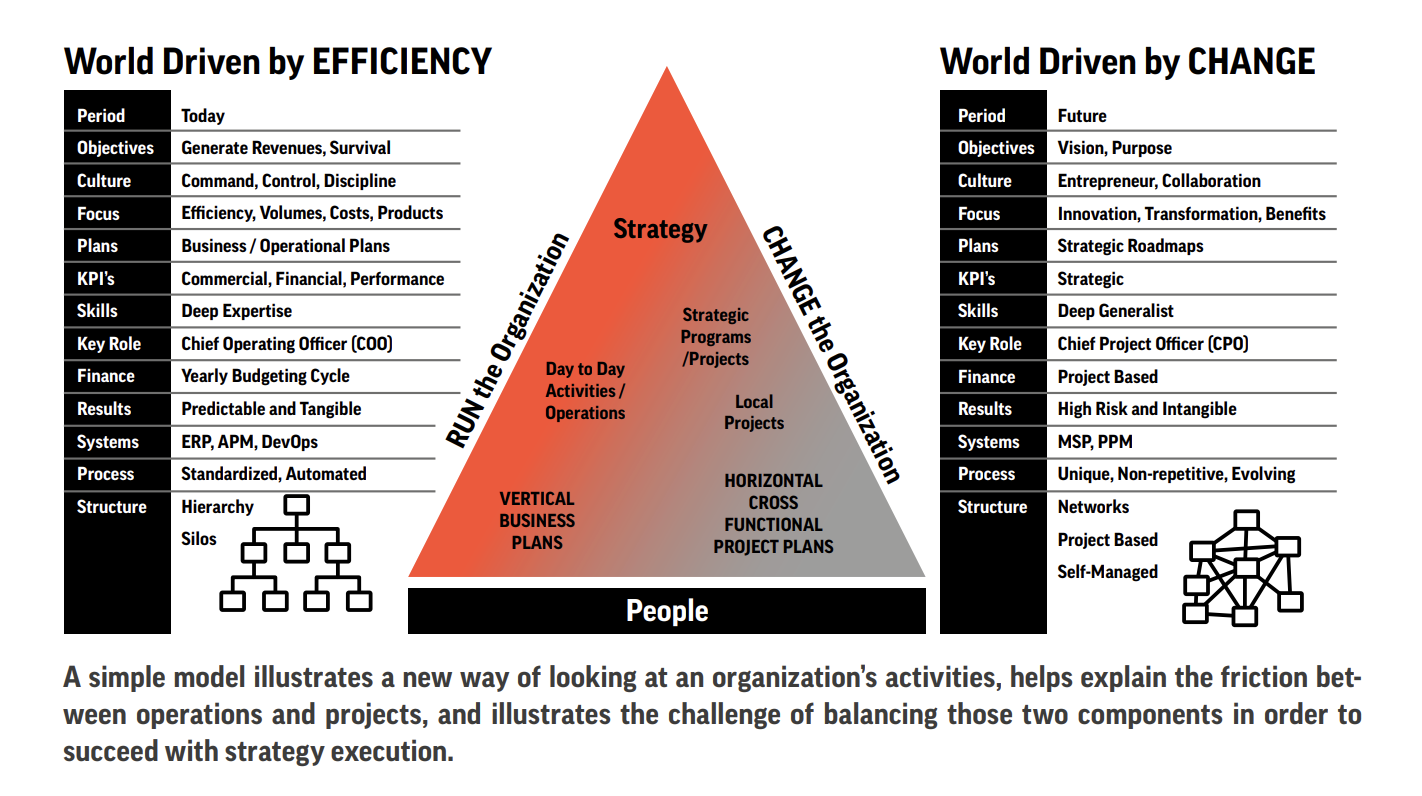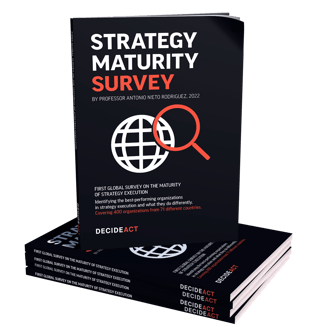Out with the old Strategy Execution, in with the new!
.png)
Why use an outdated paper map to navigate strategically when you could just as easily use an up-to-date GPS?
Despite the availability of modern digital tools for strategy execution, many companies are reluctant to use them. This is surprising, considering how difficult it is for both public and private organizations to implement and execute their strategic priorities. In this article, I dive a little deeper into why the old approach isn't producing the desired results, why it's an ever-growing problem, and how technology can solve it.
I am fully aware that there are many ways of executing strategy, just as there are many opinions and views on what strategy execution and Strategy Execution Management (SEM) is. My view is that the purpose of SEM must be based on two very important pillars: “Change the business” and “Run the business”.
The first pillar: “Change the business”. No one creates a strategy unless there is some desire to change and transform the business—a desire to move from one state to a new state. This transformational change of the company is, very often, about how we can grow the company or, how we can perhaps innovate and reinvent ourselves. It can be out of a proactive mindset of ensuring its relevance in the market in the longer term, but it can also be out of necessity; for example, many companies have had to change very quickly during the COVID-19 pandemic.
The second Pillar: “Run the business”. This pillar is just as important because strategy is also fundamentally about the operation of the business itself and how the current organization, culture, and activities can be optimized. How can we make them more appropriate? How can we make them more efficient? How can we make them ready to receive projects transformation to change the business? So, Strategy Execution Management is also about approaching strategy in a more holistic way.
Changing and running the business
An organization is like a living organism where things are interconnected, and viability depends on things being properly aligned with each other. A good strategy takes this into account and is designed in such a way that change and operations interact and work well together.
A few years ago, I wrote a white paper with Antonio Nieto-Rodriguez, the official world champion in project management and former president of PMI (Project Management Institute). We used this model from Antonio's new book, and it illustrates very precisely what this duality of operations and change is all about.

The two sides are very different. On the one hand, it is about ensuring that operations and core business run as efficiently and smoothly as possible. At the same time, the business must be constantly developed so that the company remains relevant in the market in 5, 10 and 20 years.
The processes associated with operations and transformational change are similar in basic structure, but as the model shows, they are considered with very different approaches - and when we talk about strategy, it is crucial, as mentioned above, that it is implemented and executed in a collaborative way.
Running into a perfect storm
None of this is new, in many ways this is how change and transformation processes have always been. What is new is that external changes seem to be more pervasive, while at the same time happening at an increasingly rapid pace. This requires a high degree of agility and adaptability in the way companies execute their plans and strategy. Something that only modern Strategy Execution Management is equipped to handle.
In recent years, many organizations have experienced what could be described as a perfect storm. First, there was Covid, which was a crisis for many businesses and communities and has had a major impact on many people's lives and economies. In its wake, Russia started a war in Ukraine, we had runaway inflation, in Europe we had an energy crisis, and we may have a bigger crisis ahead of us in the form of recession.
As former world champion boxer Mike Tyson said: “Everyone has a plan until they get hit in the mouth.” Applied to business, this means that as we are met with more and more surprises and changes from our environment, we need to react and act on these, and we need to do so quite quickly.
If we are to react and act as quickly as is needed in modern management, we can no longer use an outdated approach. So, out with the spreadsheets, out with the PowerPoints, out with the meetings where people must explain what they have done in the last three, six, or nine months to advance the strategy. Because who wins that battle every time in the boardroom or in the executive meeting? It's obviously the guy who comes up with the most compelling PowerPoints. One of the big questions to ask is: why are Chief Strategy Officers so hesitant to digitalize the execution when everybody knows that it’s all about data?
An outdated approach for lack of a better transformational change
The truth is that it's not presenting skills that make a real difference. It shouldn't be necessary to meet just to get an overview of how you're working on strategy. You don't call everyone from every department once a month and ask them how much money they've spent and how much they've earned.
Such basic and vital data for the company is the most natural thing in the world for management to have access to, whenever they want, via an accounting balance sheet with a real-time overview, and this is in an accounting system dedicated to just that. Just as there is a CRM system to manage and monitor everything related to customer relations, and an HR system for everything related to employees.
Given the extent to which digital tools have made inroads into virtually all management disciplines in business and government, it is thought-provoking that strategic management is still done using old-fashioned planning and presentation applications and physical meetings. The fact is that strategy execution today is largely carried out in much the same way as it was in the 1950s, when it first became a business discipline.

So far, it has been for lack of a better alternative. But that explanation no longer applies. New digital Strategy Execution Management tools are now available and ready to use, and the most forward-thinking companies have started using them. But the majority are hesitant and that's surprising because the success rate when it comes to business strategies, in general, is far from impressive.
The approach to strategy is too manual, it is time for change!
Martin Reeves of Boston Consulting says that three out of four strategies fail to achieve their goals or are not implemented as intended. The Brightline Initiative documented a few years ago that about $3 million is wasted every minute on strategies that are not implemented. In other words, it's a problem that a lot of leaders in both private and public companies know about.
What strategic execution is about is achieving the intended value of the strategic effort. It must therefore be frustrating to think that every time a large amount of money is invested in new and vital strategic change or transformation projects, it is more than likely that 75% of that amount delivers what amounts to zero value! Therefore, we need to rethink and modernize strategy execution so that this management discipline finally catches up with the others.
A major problem as it stands is that the approach to strategy is too manual. This means that it can be difficult to be systemic and structured in the way strategies and their execution are handled. We should be able to know exactly what the status is, right now, and what the likelihood is of reaching the target if we do not adapt to changing and transformational conditions. Not only in terms of KPIs but also in terms of each strategic initiative, what is executed when, where we are at risk of failing, etc.
People must be engaged in the strategy
But perhaps the worst thing about this outdated approach is that employees have no clue how they can contribute. Various studies show that 95% of all employees have no idea what the strategy of their company is. They have no idea, how can they contribute to it. A different, and more modern way of engaging people is needed.
It is not enough to make grand speeches about the importance of change, transformation and visions of where we need to go. The strategy and its objectives must be made relevant to every single employee. Everyone needs to know how they can contribute. There must be a structure around it that is easy to get to and that makes it a priority on a day-to-day basis. People must be engaged in the strategy. Otherwise, it will never happen.
Finally, it is unsatisfactory that managers and people in boards and boardrooms basically do not have an overview and control of what is going on in such an important area as the future of the company.
Out with the old—in with the new
One of the first global maturity studies on strategy execution conducted by Antonio Nieto-Rodriguez shows that only 20-25% of organizations have some form of digital tool to monitor strategy.
Moreover, very few organizations distinguish between running and changing the business in strategy work, and the study shows that many organizations spend 60 to 100% of their resources on running the business. You cannot change the business and implement a strategy without allocating resources to its execution. That is simply frivolous.
The good news is that the best-performing organizations have both a strategy execution management office and a PMO office. But it's still not good enough, because too many are still stuck in the past and the analog approach to strategy execution. The time has come to say: out with the old and in with the new.
Just like following an intelligent GPS
So, what's new in strategic governance and management? The crucial difference is that you have a digital infrastructure for strategy in the form of a platform designed and dedicated to the purpose. It's the only way to create a real-time overview so you know what's going on.
In addition, the platform integrates with other systems so that it is possible to make quick decisions and engage people at all levels of the organization. After all, every business wants early notifications of where more money can be made and where money is being lost. With a modern digital Strategy Execution Management platform, the same applies if a strategic project is going off track so you know immediately if you need to adjust. This is an agile way of executing that allows you to adapt seamlessly.
Furthermore, a strategy is not a plan you make now to follow every day for the next five years. It needs to be adjusted many times along the way, just like following an intelligent GPS that shows roadblocks and other obstacles that you must drive around to reach your destination.
A modern digital platform for strategy execution is like replacing the old-fashioned paper map with a GPS. With such a tool, you can see clearly what’s coming up in front of you, while competitors relying on old-fashioned ways of executing can only see 1500 feet ahead at best. You have an overview of where you are going, while they do not. You have a way of looking around corners – they lack that. You can predict obstacles and change direction on the fly, while competitors who are still navigating by a "paper map" run straight into trouble.
The new way of executing is digital
Does this mean you need to revisit everything you have learned about developing strategies and executing them? Not at all. Essentially, you continue to do the basic things you have always done. As a leader, you still need to set the strategic focus for the next 2, 3, or 5 years. What are the objectives and the key battles to be won? You still need to ask units and departments to contribute with very clear plans and objectives at all levels.
What's new is the way you execute, the way you monitor, follow up, and create a culture where you get things done—the way you create transparency and oversight with a digital infrastructure so everyone can help deliver. One more thing: a digital strategy management platform does not make project management tools redundant. The systems complement and are connected to each other and to the finance system or ERP system.
Consider CRM systems, which have had a huge impact on businesses. In the past, customer data was scattered across multiple systems and paper files, making it difficult to maintain consistent and effective communication with customers. However, with CRM software, businesses can now centralize and organize all customer data in one place and give employees access to this data across the entire organization.
All in all, digital accounting systems, HR software, and CRM systems are examples of technologies that have had a positive impact on businesses and have revolutionized the way we do business. It's time to make the same transformational change in strategy execution management.





%20(1).png?width=596&name=DECIDE%20ACT-06%20(2)%20(1).png)




